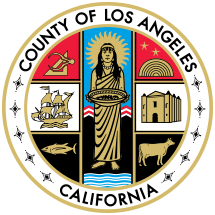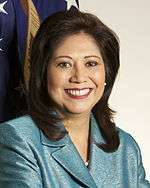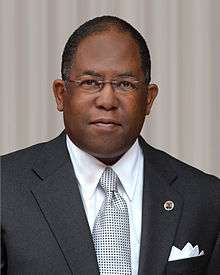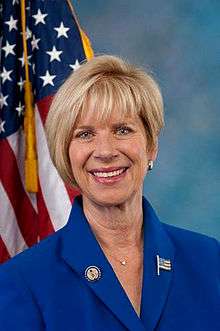Los Angeles County Board of Supervisors
| County of Los Angeles Board of Supervisors | |
|---|---|
 | |
| Type | |
| Type |
Unicameral board of Los Angeles County |
Term limits | 3 terms (12 years) |
| History | |
| Founded | 1852 |
| Preceded by | Court of Sessions |
| Leadership | |
Supervisor, First District |
Hilda Solis Since 2014 |
Supervisor, Second District (Chairman) |
Mark Ridley-Thomas Since 2008 |
Supervisor, Third District |
Sheila Kuehl Since 2014 |
Supervisor, Fourth District |
Janice Hahn Since 2016 |
Supervisor, Fifth District |
Kathryn Barger Since 2016 |
| Structure | |
| Seats | 5 |
Length of term | 4 years |
| Elections | |
Last election | November 8, 2016 |
Next election | November 6, 2018 |
| Meeting place | |
|
Kenneth Hahn Hall of Administration Civic Center, Los Angeles, California | |
| Website | |
|
bos | |
| Constitution | |
| Charter of the County of Los Angeles | |
The Los Angeles County Board of Supervisors (LAC BOS) is the five-member governing body of Los Angeles County, California.
The people of Los Angeles County on April 1, 1850 asserted their newly won right of self-government and elected a three-man Court of Sessions as their first governing body.[1] A total of 377 votes were cast in this election.[1] In 1852, the Legislature dissolved the Court of Sessions and created a five-member Board of Supervisors.[1] In 1913 the citizens of Los Angeles County approved a charter recommended by a board of freeholders which gave the County greater freedom to govern itself within the framework of state law.[1]
As the population expanded throughout the twentieth century, Los Angeles County did not subdivide into separate counties or increase the number of supervisors as its population soared. As a result, the concentration of local administrative power in each county supervisor is high with the population of the county at ten million residents. Each supervisor represents more than two million people. A local nickname some use for the Board is the "five little kings."[2]
Governance
Elections
Supervisors are elected to four-year terms by a vote of Los Angeles County citizens who reside in the supervisorial district.[3] Supervisors must reside and be voters in the district they represent.[3] Elections for the First and Third Districts coincide with California's gubernatorial elections, while those for the Second, Fourth and Fifth districts coincide with the United States presidential election.[3] Supervisorial terms begin the first Monday in December after the election.
Unseating an incumbent supervisor is extraordinarily difficult, due largely to the prohibitive cost of mounting a successful challenge in districts of such enormous geographical and population size.
Term limits
To curb the powers of the five supervisors, Los Angeles County voters passed Measure B in March 2002 with a majority of 64%, to limit the supervisors to three consecutive four-year terms.[4] If a supervisor fills a vacancy, the unexpired term counts towards the term limit if there are more than two years (half the term) left to serve. The provisions of the measure were not retroactive, meaning that the term limit clock for supervisors who were serving at the time the measure passed would start with the next election. Don Knabe, Mike Antonovich, and Yvonne Brathwaite Burke could continue to serve until 2016 (Brathwaite Burke chose to retire in 2008), while Gloria Molina and Zev Yaroslavsky could continue to serve until 2014.
Mayors
The chair of the Board of Supervisors has the option of calling himself or herself mayor. The title has drawn criticism as it can lead to confusion with the mayor of the city of Los Angeles. However, those who support the use of the title say that all five members of the Board of Supervisors act as "mayors" or chief executives for the millions of people who live in unincorporated areas. Only Mike Antonovich used the "mayor" title when chairing the Board, primarily to represent and promote Los Angeles County when dealing with international diplomacy and trade.[5] Otherwise, all other chairs have used the title chair, chairman, or chairwoman, depending on their preference.
CEO
Until recently, the Chief Executive Officer (currently Sachi Hamai[6]) was the appointed individual heading the county but had little power as supervisors retained the right to fire and hire department heads and often directly admonished department heads in public.
Based on an ordinance authored by Supervisors Knabe and Yaroslavsky that took effect in April 2007, the CEO directly oversees departments on behalf of the supervisors, although the Los Angeles County Fire Department, Los Angeles County Sheriff's Department, Assessor, District Attorney, Auditor-Controller, and Executive Office of the Board of Supervisors continue to be under the direct purview of the Board of Supervisors. The change was made in response to several candidates either dropping out or declining to accept the position to replace former Chief Administrative Officer David Janssen. Antonovich was the lone supervisor to oppose the change, stating that such a move would lead to a more autocratic form of government and disenfranchise the 1.3 million who live in unincorporated areas.[7]
However, this was rescinded in 2015 and the CEO has returned to a facilitation and coordination role between departments. Departments continue to submit recommendations and agenda items to the Board to be adopted and ratified, and the Board directly manages relations with the department heads instead of going through the CEO, as would be the case in a council-manager system prevalent in most of the county's cities.[8] In 2016, the CEO further recommended, and the Board approved, transferring positions considered "transactional" and focusing the CEO on "strategic" initiatives and long-term, structural issues.[9]
Board meetings
The Board meets every Tuesday at 9:30 a.m. at the Board Hearing Room (381B) at the Kenneth Hahn Hall of Administration in downtown Los Angeles.[10] On Tuesdays following a Monday holiday, Board meetings begin after lunch, at 1:00 p.m.[10] Board meetings are conducted in accordance with Robert's Rules of Order, the Brown Act (California’s sunshine law), and the Rules of the Board. The Chief Executive Officer, the County Counsel and the Executive Officer, or their deputies, attend each Board meeting.[10]
The regular agendas for the first, second, third and fifth Tuesdays of the month are essentially a consent calendar, that is, all items are automatically approved without discussion, unless a Supervisor or member of the public requests discussion of a specific item.[10] The fourth Tuesday of the month is reserved for the purpose of conducting legally required public hearings, Board of Supervisors motions and department items continued from a previous meeting, have time constraints, or are critical in nature.[10] Since Board meetings are considered Brown Act bodies, a Board agenda is published 72 hours before the Board meeting is convened.
At the start of a meeting, after an invocation and the Pledge of Allegiance, all items that do not have "holds" placed on them by a Supervisor or a member of the public, or are mandatory public hearings, are approved on a consent calendar.[10] Following that, presentations of various dignitaries (e.g., local consulate officials, awards to County employees and the general public, and pets for adoption) are made.[10] Then, items that were not approved are called in numerical order unless a supervisor wishes to take items out of order.[10]
Members of the public are allotted three minutes to make public comment on all the agenda items that they intend to discuss.[10] An additional three minutes are provided during general public comment on any topic within the board's jurisdiction.[10] Individuals must submit comment cards before the start of the meeting and wait until their item is called. On popular topics with multiple speakers, comments may be restricted to as little as one minute each, and the board has the discretion to figuratively muzzle anyone who is addressing the board in a disruptive manner.[10]
Weekly Board meetings are broadcast live online and televised on local public television (KLCS Channel 58). Transcripts and statements of proceedings are published online.[10] However, because some Board decisions have major implications, speakers and protesters on behalf of many causes regularly attend the meetings. The county is sued frequently by various public interest law firms and organizations on behalf of people who disagree with the Board's decisions.
Criticism and controversy
Board expansion
"Good-government" advocates have long supported the idea of expanding Board membership to reduce the size of each district, and establishing an elected County Executive as a check and balance on the Board's power, but voters have rejected such proposals every time they have appeared on the ballot. However, former supervisor Gloria Molina supported expansion of the Board (to potentially increase Hispanic representation), and former supervisor Zev Yaroslavsky supported both Board expansion and the creation of an elected County Executive, much like in King County, Washington.
Cooperation with ICE agents in jails
From 2005 to 2015, the board had a controversial program, known as 287(g), that allowed federal U.S. Immigration and Customs Enforcement agents into county jails to determine whether inmates were in the country legally.[11] After 2015, the board of supervisors and the Los Angeles County Sheriff's Department still cooperate with federal immigration agents.[12][13]
Interim public defender appointment
In 2018, the board appointed Nicole Tinkham as interim public defender, despite a letter signed by 390 public defenders who were concerned that Tinkham lacked criminal law experience and the potential for a conflict of interest, given Tinkham’s prior representation of the Los Angeles County Sheriff’s Department.[14][15] Prior to the appointment, the board had failed to appoint a permanent Public Defender, following the retirement of Ronald Brown.[16] One deputy public defender testified to the board: “I feel like you are making a mockery of my life’s work … clearly somebody failed to think this through.”[17] The American Civil Liberties Union has also criticized the appointment of Tinkham.[18]
Naming of public space
In 2018, the Los Angeles Times editorial board criticized the board for their decision to name a new mental health center after Supervisor Sheila Kuehl while she remained in office. Kuehl was in her first term as a Supervisor and had just assumed the board chairmanship.[19] The board also criticized other past supervisors for the same practice, such as Michael D. Antonovich.[19]
Racial and political gerrymandering
In 1991, a federal court ruled that the board denied Latinos a chance to be elected to the board. The court found that supervisors, all white, purposefully gerrymandered districts so that Latinos were a minority in each of them, a Voting Rights Act violation. As a result, Gloria Molina, the first Latina supervisor, was elected to the board of supervisors.[20]
In 2010, Los Angeles created a nonpartisan commission to impartially redraw the districts for the board of supervisors.”[21]
In 2016, Governor Brown, however, signed Senate Bill 958 which states that “the political party preferences of the commission members…shall be as proportional as possible to the total number of voters who are registered with each political party in the County of Los Angeles.”[21] Some argue that the new bill infringes upon the rights of political minority parties and independent voters.[21]
Transparency
In 2018, the Los Angeles Times editorial board criticized the board for a lack of transparency and accountability. In early 2015, the board was to discuss and adopt a set of policy priorities and post them on the county's website, together with an explanation of how they would be implemented and a schedule of hearings so the public could weigh in. The Times criticized the board for not following through on that promise.[22]
Current Supervisors
Members of the Board are officially nonpartisan, and are elected by constituents of their respective districts.[23] As of 2016, they are:
Supervisorial districts
Los Angeles County is divided into 5 supervisorial districts (SDs), with each Supervisor representing a district of approximately 2 million people.
References
- 1 2 3 4 "History - Los Angeles County". www.lacounty.gov. Retrieved 2018-02-10.
- ↑ Niki Cervantes, "Five little kings' power at stake in redistricting suit; Proposed changes would clip clout of L.A. supervisors," San Diego Union-Tribune, 10 May 1990, A3.
- 1 2 3 "Charter of the County of Los Angeles" (PDF). Board of Supervisors. County of Los Angeles. June 2006. Archived from the original (PDF) on 22 July 2013. Retrieved 10 September 2013.
- ↑ "Directory of Los Angeles County, CA Measures - March 5, 2002 Election". League of Women Voters of California Education Fund. 19 April 2002. Retrieved 10 September 2013.
- ↑ http://articles.latimes.com/1996-10-26/local/me-57951_1_mayor-office
- ↑
- ↑ Power Shift Means Less Accountability, More Bureaucracy
- ↑ http://www.latimes.com/local/california/la-me-0708-county-ceo-20150708-story.html
- ↑ http://file.lacounty.gov/SDSInter/bos/supdocs/102033.pdf
- 1 2 3 4 5 6 7 8 9 10 11 12 "Information Regarding Agendas and Meetings of the Board of Supervisors". Executive Office. County of Los Angeles. Retrieved 10 September 2013.
- ↑ Holguin, Robert (2015-05-13). "L.A. County Board of Supervisors ends 287(g) immigration enforcement program". ABC7 Los Angeles. Retrieved 2018-02-13.
- ↑ Radio, Southern California Public (2015-09-23). "LA County will continue to cooperate with immigration agents". Southern California Public Radio. Retrieved 2018-02-13.
- ↑ "How should LA County Sheriff's Department deal with ICE? Residents divided over watchdog's report in heated meeting". Daily News. 2017-10-26. Retrieved 2018-02-13.
- ↑ "Hundreds of deputy public defenders protest choice of new interim leader". theavtimes.com. Retrieved 2018-02-10.
- ↑ "County Board of Supervisors Fumbles the Public Defender Appointment". KNOCK. 2018-02-03. Retrieved 2018-02-10.
- ↑ Board, The Times Editorial. "Is the new public defender ending or stoking office turmoil?". latimes.com. Retrieved 2018-02-10.
- ↑ "Hundreds Of LA County Public Defenders Protest Appointment Of Interim Leader - LA West Media". LA West Media. 2018-01-23. Retrieved 2018-02-10.
- ↑ Radio, Southern California Public (2018-02-01). "The L.A. County supervisor's pick for interim head of the public defender's office faces criticism". Southern California Public Radio. Retrieved 2018-02-10.
- 1 2 Board, The Times Editorial. "A note to L.A. County's supervisors: Stop naming things after yourselves. It's obscene". latimes.com. Retrieved 2018-02-24.
- ↑ "Race and county redistricting". Bill Boyarsky on LA Observed. Retrieved 2018-02-10.
- 1 2 3 "A Case of Democratic Gerrymandering in LA County". Davis Political Review. 2017-05-03. Retrieved 2018-02-10.
- ↑ Board, The Times Editorial. "If L.A. supes can't bother to update their website, how can we trust them to keep the public informed?". latimes.com. Retrieved 2018-02-10.
- ↑ Sewell, Abby (3 April 2016). "This year's election could usher in liberal 'supermajority' on L.A. County supervisors board". Los Angeles Times. Retrieved 31 October 2016.
- ↑ "First Supervisorial District Map" (PDF). Chief Executive Office. County of Los Angeles. January 2012. Retrieved 10 September 2013.
- ↑ "Second Supervisorial District Map" (PDF). Chief Executive Office. County of Los Angeles. January 2012. Retrieved 10 September 2013.
- ↑ "Third Supervisorial District Map" (PDF). Chief Executive Office. County of Los Angeles. January 2012. Archived from the original (PDF) on 27 December 2012. Retrieved 10 September 2013.
- ↑ "Fourth Supervisorial District Map" (PDF). Chief Executive Office. County of Los Angeles. January 2012. Archived from the original (PDF) on 23 December 2012. Retrieved 10 September 2013.
- ↑ "Fifth Supervisorial District Map" (PDF). Chief Executive Office. County of Los Angeles. January 2012. Retrieved 10 September 2013.


.jpg)

